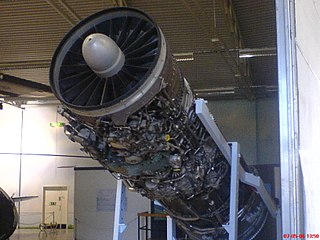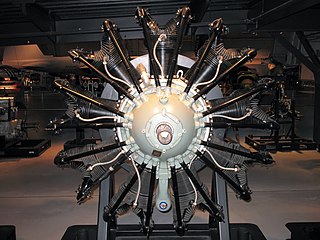Related Research Articles

The Rolls-Royce RB.44 Tay was a British turbojet engine of the 1940s, an enlarged version of the Rolls-Royce Nene designed at the request of Pratt & Whitney. It saw no use by British production aircraft but the design was licence built by Pratt & Whitney as the J48, and by Hispano-Suiza as the Verdon.

The Pratt & Whitney J57 is an axial-flow turbojet engine developed by Pratt & Whitney in the early 1950s. The J57 was the first 10,000 lbf (45 kN) thrust class engine in the United States. The J57/JT3C was developed into the J75/JT4A turbojet, JT3D/TF33 turbofan, and PT5/T57 turboprop. The J57 and JT3C saw extensive use on fighter jets, jetliners, and bombers for many decades.

The Pratt & Whitney Wasp was the civilian name of a family of air-cooled radial piston engines developed in the 1930s, 1940s, and 1950s.

The Pratt & Whitney R-1535 Twin Wasp Junior was an engine used in American aircraft in the 1930s. The engine was introduced in 1932 as a 14-cylinder version of the 9-cylinder R-985. It was a two-row, air-cooled radial design. Displacement was 1,535 in³ (25.2 L); bore and stroke were both 5-3/16 in (131.8 mm).

The Pratt & Whitney R-1690 Hornet was a widely used American aircraft engine. Developed by Pratt & Whitney, 2,944 were produced from 1926 through 1942. It first flew in 1927. It was a single-row, 9-cylinder air-cooled radial design. Displacement was 1,690 cubic inches. It was built under license in Italy as the Fiat A.59. In Germany, the BMW 132 was a developed version of this engine. The R-1860 Hornet B was an enlarged version produced from 1929.

The Rolls-Royce Eagle Mk XXII was a British 24-cylinder, sleeve valve, H-block aero engine of 46 litre displacement. It was designed and built in the early-1940s by Rolls-Royce Limited and first ran in 1944. It was liquid-cooled, of flat H configuration with two crankshafts and was capable of 3,200 horsepower at 18 psi boost.

The Allison TF41 is a low-bypass turbofan engine.

The geared turbofan is a type of turbofan aircraft engine, with a gearbox between the fan and the low pressure shaft to spin each at optimum angular velocities.

The Pratt & Whitney J48 is a turbojet engine developed by Pratt & Whitney as a license-built version of the Rolls-Royce Tay. The Tay/J48 was an enlarged development of the Rolls-Royce Nene.

The Pratt & Whitney R-2000 Twin Wasp is a radial engine developed in the United States in 1942 to power military aircraft. It is one of the Pratt & Whitney Wasp series of radial engines.

Pratt & Whitney Measurement Systems is an American multinational corporation that specializes in producing high-precision measuring instruments and systems.

The Pratt & Whitney X-1800 was an H-block aircraft engine project developed between 1938 and 1940, which was cancelled with only one example being built.
The Garrett F109 was a small turbofan engine developed for the Fairchild T-46 by Garrett AiResearch. With the United States Air Force's cancellation of the T-46 program in 1986, further development of the engine ceased, and with it the civil TFE109 version.

The Pratt & Whitney T34 was an American axial flow turboprop engine designed and built by Pratt & Whitney. Its only major application was on the Douglas C-133 Cargomaster.

The Pratt & Whitney R-2180-E Twin Wasp E was a radial aircraft engine developed in the United States by Pratt & Whitney. It had two rows of seven cylinders each. Its only production application was on the post-World War II Saab 90 Scandia airliner.

The Continental CAE T51 was a small turboshaft engine produced by Continental Aviation and Engineering (CAE) under license from Turbomeca. A development of the Artouste, it was followed by three additional turboshaft engines, the T72, the T65, and the T67. However, none of these engines, including the T51, entered full production. CAE abandoned turboshaft development in 1967 after the XT67 lost to the Pratt & Whitney Canada PT6T (T400) to power the Bell UH-1N Twin Huey.

The Volvo RM8 is a low-bypass afterburning turbofan jet engine developed for the Saab 37 Viggen fighter. In 1962, the Pratt & Whitney JT8D-1 engine was chosen to power the Viggen in absence of a suitable and available engine designed for military use. Basically a licensed-built version of the JT8D, heavily modified for supersonic speeds, with a Swedish-designed afterburner, the RM8 was produced by Svenska Flygmotor.

The Pratt & Whitney R-1860 Hornet B was a relatively uncommon aircraft engine. It was a development of Pratt & Whitney's earlier R-1690 Hornet and was basically similar, but enlarged in capacity from 1,690 to 1,860 cubic inches (30.5 L). Cylinder bore was increased by 1/8" and the crankshaft stroke by 3/8". Both engines were air-cooled radial engines, with a single row of nine cylinders.
The Pratt & Whitney R-2060 Yellow Jacket was a liquid-cooled aircraft engine project developed for the United States Army in the early 1930s. The engine had five banks of four in-line cylinders, and displaced 2,060 cubic inches. Designed to produce 1,000 hp, the engine produced 1,116 hp on its final run after 35 hours of testing. The engine was cancelled in favor of continuing development of Pratt & Whitney's air-cooled R-1830 Twin Wasp radial engine.

The Pratt & Whitney R-2180-A Twin Hornet was a radial engine developed in the United States by Pratt & Whitney. It had two rows of seven cylinders each.
References
Notes
Bibliography
- Connors, Jack (2010). The Engines of Pratt & Whitney: A Technical History. Reston. Virginia: American Institute of Aeronautics and Astronautics. ISBN 978-1-60086-711-8.
- Gunston, Bill (2006). World Encyclopedia of Aero Engines, 5th Edition. Phoenix Mill, Gloucestershire, England, UK: Sutton Publishing Limited. ISBN 0-7509-4479-X.
- Gunston, Bill (1999). The Development of Piston Aero Engines, 2nd Edition. Sparkford, Somerset, England, UK: Patrick Stephens, Haynes Publishing. ISBN 0-7509-4478-1.